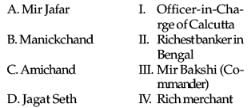Test: The East India Company And The Bengal Nawabs - 1 - UPSC MCQ
30 Questions MCQ Test - Test: The East India Company And The Bengal Nawabs - 1
When did Calcutta become the seat of a Presidency under the name of Fort William?
Which was the earliest instance of bitterness between the Nawab of Bengal, Siraj-ud-daulah, and the East India Company?
In 1756 Siraj-ud-daulah attacked a British factory at a place which produced silk. The place was
In 1756 Siraj-ud-daulah forbade the English and the French from strengthening their fortifications. The French agreed but the English didn’t. Why?
Which is TRUE about the attack on Calcutta by Siraj-ud-daulah in 1757?
The Black-Hole Tragedy supposedly took place at
Chandernagar was the only French settlement in Bengal. It was captured in 1757 by the
Which one of the following sided with the English against Siraj-ud-daulah, despite being one of the commanders of the latter’s forces
In 1757 the English had re-captured Calcutta from Siraj-ud-daulah. This was mainly due to the help from the enemies of the Nawab and the aid that came from
Which is TRUE about the treaty of 1757?
Siraj-ud-daulah was betrayed by some of his associates. Match these officials with the positions/status they enjoyed:

Who was chosen to act as mediator between the English and Siraj-ud-daulah and later was fooled by Robert Clive?
The Battle of Plassey was fought on
The major part of Siraj-ud-daulah’s army was led by two traitors who took no part in the Battle of Plassey. They were
What happened to Siraj-ud-daulah after the Battle of Plassey which the English won?
What was the significance of the Battle of Plassey?
After the Battle of Plassey, the East India Company was granted undisputed right to free trade in
Mir Jafar, the new Nawab of Bengal, repented his bargain with the English, because the latter soon drained his treasury.
Who remarked “the single aim of the Company’s officials was to grasp all they could; to use Mir Jafar as a golden sack into which they could dip their hands at pleasure”?
Who ordered that Bengal should pay the expenses of the Bombay and Madras Presidencies and purchase out of its revenue all the Company’s exports from India?
In 1759 Mir Jafar was forced to seek the help of a power against the English. It was the
In October 1760, Mir Jafar was abdicated in favour of his son-in-law, Mir Qasim who gave the Company the zamindari of
Mir Qasim was deposed. Mir Jafar was again made the Nawab of Bengal in
Mir Qasim was an efficient ruler. Which action of his was disliked most by the East India Company?
The Company’s servants illegally sold the dastaks or free passes to friendly.
Which drastic step of Mir Qasim greatly angered the Company?
The new capital of Mir Qasim was
Mir Qasim formed an alliance with
The Battle of Buxer was fought between Mir Qasim and his allies and the English on
Which of the following fled from the battlefield at Buxer?
The English won the Battle of Buxar. The state of which Shuja- ud-daulah was the ruler was a their mercy after the battle. The state was



















